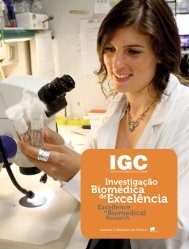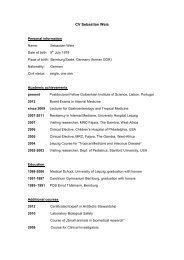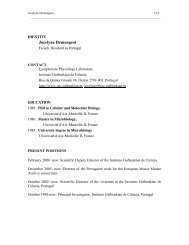organisation - the Instituto Gulbenkian de Ciência
organisation - the Instituto Gulbenkian de Ciência
organisation - the Instituto Gulbenkian de Ciência
- No tags were found...
Create successful ePaper yourself
Turn your PDF publications into a flip-book with our unique Google optimized e-Paper software.
During <strong>the</strong> second year of <strong>the</strong> project we were able to i<strong>de</strong>ntify a set of 237 conserved<br />
orthologue gene products that are expressed in <strong>the</strong> male gametes of <strong>the</strong><br />
three species. These products, by encoding both for evolutionarily-conserved<br />
germline regulators and for general housekeeping functions, represented <strong>the</strong><br />
starting point for <strong>the</strong> subsequent selection of 32 genes belonging to a putative<br />
core set of germline <strong>de</strong>terminants. These candidates genes are currently being<br />
characterised in Drosophila.<br />
MOLECULAR AND FUNCTIONAL CHARACTERISATION OF SPERM-EXPRESSED<br />
PROTEINS WITH POTENTIAL FUSOGENIC ROLES DURING DOUBLE<br />
FERTILISATION IN Arabidopsis thaliana<br />
Sexual reproduction is a fundamental biological process common among eukaryotes.<br />
In flowering plants, fertilisation involves a double fusion event between<br />
two male and two distinct female gametes. The signalling interactions involved<br />
in <strong>the</strong>se two in<strong>de</strong>pen<strong>de</strong>nt fusion events are still poorly un<strong>de</strong>rstood and <strong>the</strong><br />
molecular effectors mostly unknown. The project aims to i<strong>de</strong>ntify <strong>the</strong> central<br />
protagonists of <strong>the</strong>se cellular interactions, i.e. proteins preferentially localised<br />
to <strong>the</strong> surface of gametes exhibiting a function that is required for cell-cell adhesion<br />
or fusion. Ultimately we expect to answer some fundamental questions<br />
un<strong>de</strong>rlying gamete fusion: How do sperm and egg cell recognise each o<strong>the</strong>r and<br />
fuse? Is <strong>the</strong>re any specificity in <strong>the</strong> two different cell-cell fusion events? Are <strong>the</strong><br />
proteins involved specific to cell-cell fusion? And what is <strong>the</strong> interplay, if any,<br />
between <strong>the</strong>se proteins and <strong>the</strong> downstream signalling events leading to <strong>the</strong><br />
successful production of a seed?<br />
Transgenic Arabidopsis pollen grains expressing H2B-mRFP in <strong>the</strong> vegetative cell<br />
nucleus (red) and MGH3-eGFP specifically localised to <strong>the</strong> sperm cell nuclei (green)<br />
allow <strong>the</strong>ir co-purification by FACS.<br />
We are currently focused on <strong>the</strong> functional analysis of two sperm-expressed<br />
tetraspanins and in <strong>the</strong> i<strong>de</strong>ntification of partner molecules on male and female<br />
gametes.<br />
PLANTORIGINS<br />
The Marie Curie ITN “PLANT <strong>de</strong>velopmental biology: Discovering <strong>the</strong> ORIGINS of<br />
form” aims to integrate new discoveries and approaches in <strong>the</strong> fields of plant<br />
morphology, systematics, and <strong>de</strong>velopmental genetics with <strong>the</strong> overall goal of<br />
un<strong>de</strong>rstanding how <strong>the</strong> major tissues and organ systems of plants evolved and<br />
what <strong>the</strong>ir genetic regulatory basis is. We are focusing on <strong>the</strong> i<strong>de</strong>ntification of<br />
conserved networks functioning in sperm cells to assure correct <strong>de</strong>velopment<br />
and viability of this unique cell type, using a comparative transcriptomics approach<br />
comparing gene expression in male gametes of <strong>the</strong> angiosperm Arabidopsis<br />
thaliana and <strong>the</strong> bryophyte Physcomitrella patens. Candidate genes<br />
within <strong>the</strong> most promising conserved modules will be selected for functional<br />
characterization in Arabidopsis and Physcomitrella. This should ultimately allow<br />
a better un<strong>de</strong>rstanding of <strong>the</strong> evolution of regulatory modules un<strong>de</strong>rlying<br />
sperm <strong>de</strong>velopment, viability and fertilisation in <strong>the</strong> plant lineage.<br />
During 2011 we have established <strong>the</strong> moss Physcomitrella patens as a mo<strong>de</strong>l system<br />
in our lab. Subsequently we have <strong>de</strong>veloped a collection method for sperm<br />
cells (an<strong>the</strong>rozoids) and archegonia from Physcomitrella based on micromanipulation<br />
that will allow us to analyse <strong>the</strong> transcriptome by microarray analysis.<br />
IGC ANNUAL REPORT ‘11<br />
RESEARCH FELLOWS<br />
72






